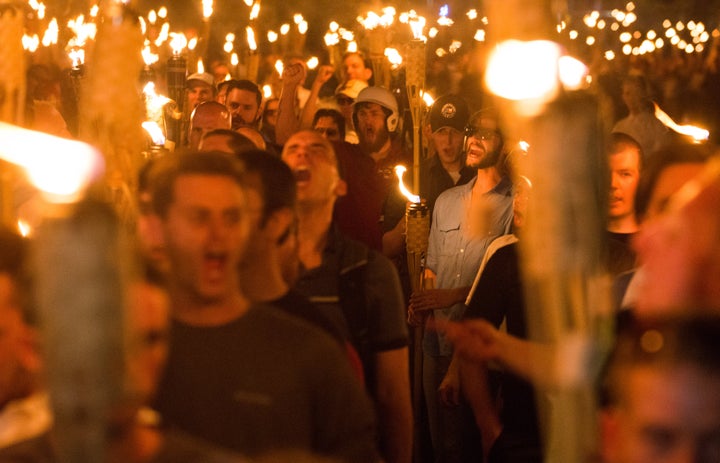Jury selection began Monday in an ambitious civil lawsuit against two dozen white nationalist individuals and organizations four years after a sweeping coalition of neo-Nazis, white supremacists and other extremist factions descended on Charlottesville, Virginia, for a hate-fueled weekend rally that left one woman dead and many more people injured.
Attorneys representing nine members of the Charlottesville community will attempt to prove that the defendants — a range of far-right groups and white supremacist figureheads, including Richard Spencer, Jason Kessler and Christopher Cantwell — conspired to commit acts of racial violence and force them to pay damages that could leave them in financial ruin.
As a group, the plaintiffs ― who are Black, white and multiracial ― represent the kind of diversity the defendants oppose in America. The plaintiffs’ attorneys are hoping a 19th century law will help them succeed in the civil suit. Under the Ku Klux Klan Act of 1871, which was enacted to protect the civil rights of newly freed slaves from white bigots, victims of racially motivated violence are allowed to sue their perpetrators in federal court.
“First and foremost, this is about justice for our plaintiffs and accountability for the defendants, which is all the more important given the stunning lack of accountability we’ve seen when it comes to white supremacy in recent years,” said Amy Spitalnick, executive director of Integrity First for America, the nonprofit funding the lawsuit.
“By winning large financial judgments at trial, this case can also effectively bankrupt and dismantle a number of the groups,” she added.

During jury selection at the Charlottesville federal courthouse on Monday, U.S. District Judge Norman K. Moon dismissed some potential jurors for having negative views of anti-racism demonstrators and anti-fascist activists, sometimes known as “antifa.” One man said he viewed antifa as “troublemakers” but believed he could be impartial at trial and was permitted to join the jury. Each juror was asked to complete a questionnaire asking how concerned they felt about racism against different groups, such as Black people or Jewish people.
Once the jury is seated, the trial is expected to last several weeks.
Some defendants have already complained about the financial toll the long-running case has taken. Spencer, who is credited with coining the phrase “alt-right,” has been living at his mother’s house in Whitefish, Montana, and will represent himself in court to save money. So will Cantwell, who was dubbed “the crying Nazi” for his emotional reaction after learning there was a warrant for his arrest.
At least two defendants are believed to be in hiding.
The groups targeted in the lawsuit, and their overlapping ideologies, are well-known to extremism researchers. They include Vanguard America, whose members believe people with “white blood” have a bond with “American soil,” and Identity Evropa, whose members champion “white American identity.”
The “Unite the Right” rally in August 2017 was ostensibly a chance for right-wingers to protest the proposed removal of a monument to the defeated Confederate Gen. Robert E. Lee. The white nationalist who obtained a permit from the city for the weekend rally, Jason Kessler, is among the defendants.
Digital messages between organizers and participants would later show how many of the event’s organizers seemed to anticipate and fervently encourage the violence that ultimately transpired and the hatred that was displayed.
Attorneys for the plaintiffs will use those digital records ― in total, they have sifted through 5.3 terabytes of data related to the case ― in order to make their argument. They will need to prove two things: that the defendants conspired to commit acts of violence, even if they did not all know each other beforehand, and that the violence was “motivated by racial animus,” Spitalnick told HuffPost.
“Clearly, we think it’s quite a strong case,” she said.
Some of the planning conversations have already leaked out; screenshots from the communications platform Discord were published online not long after the Unite the Right event.
“But there’s stuff we haven’t seen yet ― text messages and internal private chat rooms and things like that,” noted Emily Gorcenski, a data scientist from Charlottesville who has been working to document white supremacist violence across the United States. “So I think that, looking forward, that evidence being revealed in public will be interesting.”
Images from the Unite the Right rally ― crowds of angry white men blending American flags with racist and anti-Semitic iconography ― provided a stunning reminder of the hateful ideologies that still permeate parts of the United States.
On the evening of Friday, Aug. 11, 2017, a crowd of white nationalists and neo-Nazis surrounded Charlottesville’s Robert E. Lee statue carrying tiki torches, chanting, “Jews will not replace us” and “White lives matter!”
The coalition then marched to the University of Virginia’s campus rotunda, where a group of about two dozen counterprotesters were gathered at a statue of President Thomas Jefferson, who founded the campus. Two plaintiffs, Natalie Romero and John Doe, were doused with fluid that they thought could be flammable. John Doe ― a Black man who wishes to be anonymous out of fear for his safety ― was afraid he might die being in such close proximity to a hostile mob with lit torches, court documents say.
One of the defendants, Robert “Azzmador” Ray, who writes for the neo-Nazi website the Daily Stormer, allegedly shouted, “The heat here is nothing compared to what you’re going to get in the ovens!”
The following day, a 20-year-old neo-Nazi, James Alex Fields Jr., deliberately drove his gray Dodge Challenger into a crowd of counterprotesters. More than 30 people were injured, some gravely, and one died: 32-year-old Heather Heyer.
“The aim of this lawsuit,” states an amended complaint filed in 2019, “is to ensure that nothing like this will happen again at the hands of Defendants ― not on the streets of Charlottesville, Virginia, and not anywhere else in the United States of America.”
“This was never about a free speech rally. They planned to inflict violence. And we knew that, and we tried to sound the alarm but were dismissed as crazy, flailing, arm-waving leftists who just want to shut down free speech.”
- Jalane Schmidt, associate professor of religious studies at the University of Virginia
Several of the plaintiffs in the lawsuit were seriously injured by Fields, who was sentenced to life in prison in 2019.
Thomas Baker was walking with a group of counterprotesters on Aug. 12 when he was struck by Fields’ vehicle and thrown into the air, suffering a concussion, a torn ligament in his left wrist and a torn labrum in his right hip that required surgery. He missed more than a month of work and has had trouble even standing for long periods of time without pain.
Romero, then an undergraduate at the University of Virginia, was also hit by the car, which knocked her to the ground and fractured her skull. She continues to suffer vertigo and “debilitating” headaches, court documents say.
Marcus Martin managed to push his fiancée out of the path of the Dodge Challenger but got hit himself, suffering a broken leg and ankle. He can be seen wearing red-and-white shoes in the Pulitzer Prize-winning photograph taken of the crash by Ryan M. Kelly.
All of the plaintiffs say they have emotional scars from the Unite the Right rally weekend.
The Lee statue was finally removed last July. A museum for Black culture and history, the Jefferson School African American Heritage Center, wants to melt it down and use the bronze to create new public art.
Jalane Schmidt, a Black Lives Matter activist and associate professor of religious studies at the University of Virginia, has been working for years to push back against the type of hateful views espoused by the Charlottesville defendants.
In some ways, she told HuffPost, the trial is a “vindication of the activism, the vigilance and the vehemence of local anti-racist activists.”
Schmidt recalled being treated with skepticism by others in the Charlottesville community prior to Unite the Right. In 2017, she said, “we were getting a constant message that we were the problem,” trying to prevent people like Spencer from exercising his First Amendment rights.
“We were onto this early. We saw it for what it was,” Schmidt said. “This was never about a free speech rally. They planned to inflict violence. And we knew that, and we tried to sound the alarm, but were dismissed as crazy, flailing, arm-waving leftists who just want to shut down free speech.”
“So this is a sense of vindication and seeing the clear parallel with Jan. 6, where people are planning out in the open that they’re going to do this. And then, sure enough, it comes to pass,” Schmidt said.
Gorcenski also sees a clear line between Charlottesville to the right-wing violence that exploded on Capitol Hill early this year and stressed the importance of the work local activists have been doing to fight for civil rights.
The movement to bring down the Lee statue was started by a 15-year-old ― a Black girl named Zyahna Bryant who started a Change.org petition in 2016.
“Long after the cameras are gone and the verdict is in, these are people who will continue doing the work because Charlottesville is not just about what happened in 2017. Charlottesville is an ongoing story with ongoing struggles, and has been for 400 years and will be for another 400 years,” Gorcenski said.
“For the locals, Richard Spencer will come and go, and all of these guys, but our struggle, our love, our community, our bonds will be here forever.”

